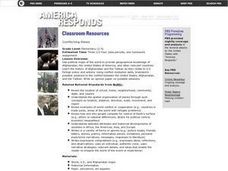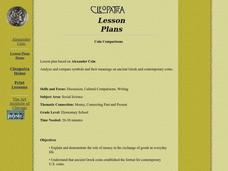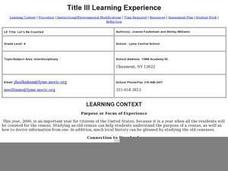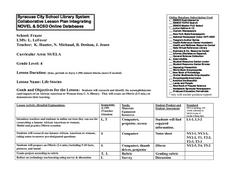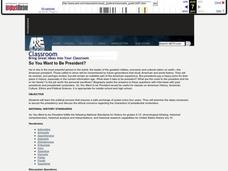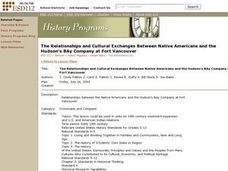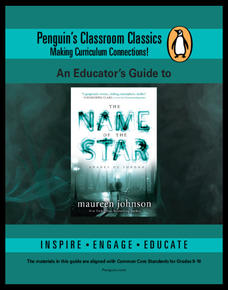Curated OER
Conflicting Views
Students complete a Venn diagram comparing the United States and Afghanistan. They research the history of the Taliban and how they relate to the United States and its foreign policy. They write a paper on possible solutions.
Curated OER
In Remembrance of George Washington
Students explore the contributions of George Washington. In this early American history lesson, students analyze the provided eulogy for George Washington written by Henry Lee and then write their eulogies for the first president.
Curated OER
Little Kinnakeet Lifesaving/Coast Guard Station
Students complete a variety of activities that go along with the study of and possible field trip to the Little Kinnakeet Lifesaving/Coast Guard Station on the Cape Hatteras National Seashore, NC.
Curated OER
Coin Comparisons
Students analyze and compare symbols and their meanings on ancient Greek and contemporary coins.
Curated OER
Uniform Blues
Fourth graders explore what the U.S. Constitution is and why it is important, the purpose of the state constitution, and its relationship to the U.S. Constitution and the similarities and differences among federal, state and local...
Curated OER
Let's Be Counted
Fourth graders study census-taking. They participate in a variety of activities surrounding the U.S. census of 2000. They compare a modern census to one of 1905.
Curated OER
Donut Dinero
Students set up a classroom currency exchange and explore the idea of bartering to get what they want. They create a monetary unit that is based on fractions and multiples of a standard unit, and compare this system to the U.S. monetary...
Curated OER
Life Stories
Fourth graders create a brief video presentation documenting their research of an impactful African American or woman from history. Students research and identify their accomplishments and create a 2-5 minute iMovie documenting their...
Curated OER
So You Want to Be President?
Young scholars view a documentary on U.S. Presidents. Those called to serve be remembered by future generations that study American and world history. After viewing, students discuss what they saw then create a poster about the electoral...
Curated OER
Form and Function
Students discover the function of ancient Greek vessels by comparing their characteristics. They compare and contrast two ancient Greek vessels to determine the function of each.
Curated OER
Social Studies: Debating Aid to Micronesia
Learners simulate a debate about continued U.S. aid to the Federated States of Micronesia. In two large groups, they research the history of Micronesia and how it was affected by colonization and trusteeship. After the debate, students...
Curated OER
Investigating the Mammoth Mystery
Fourth graders go on a virtual dig to find out where the mammoth bones found in a rural U.S. county came from. They determine whether the bones were created by humans or were they the actual remains of mammoths who walked the area during...
Curated OER
Tracing Our Own Family Pilgrimages
Students observe a world map and are introduced to vocabulary like: cities, continents, rivers, lakes, and oceans. They discuss the names of the cities they live in and locate them on the map; then using a colored pushpin indicate: the...
Curated OER
Superhighway Scholars
Students study the states of their choice by using Superhighway Scholars website. In this Unites States history lesson plan, students create a collage using information collected about a state of their choosing. This lesson plan provides...
Curated OER
The Relationships and Cultural Exchanges Between Native Americans and the Hudson's Bay Company at Fort Vancouver
Learners are introduced to the geography of the Columbia River basin and its history. Using the internet, they research the relationships between the Native Americans and the Hudson Bay Company. They also discuss the effects on the...
Curated OER
Understanding The Progressives And Their Viewpoints
Eleventh graders explore the Progressive Era in American history (1900-1917). They use the internet and other sources to research the Progressive Movement, identify three Progressive presidents, and explore considered reforms. Students...
Curated OER
French and Indian War
Eighth graders examine the French and Indian war and the many events that led up to it. They read a section of their history textbook and write four questions and the answers to the questions. Students then trade questions with another...
Curated OER
World War II: "The Other" Americans
Eleventh graders examine the roles of women and minorities during Word War II. In this American History instructional activity, 11th graders watch the video "Saving Private Ryan". Students read a book on the topic and answer...
National Museum of the American Indian
The Kwakwaka'Wakw: A Study of a North Pacific Coast People and the Potlatch
Discover the cultural practices and unique value systems of a group of native peoples from Canada called the Kwakwaka'wakw. Your young historians will discuss how conceptions of wealth can vary and how these native people utilized...
Constitutional Rights Foundation
Educating About Immigration The DREAM Act
Group members role play state legislators, supporters of and opponents to the The DREAM Act (Development, Relief, and Education for Alien Minors). After listening to the arguments put forth for and against the immigration legislation,...
Anti-Defamation League
Martin Luther King, Jr. and Civil Rights
How far have we come and how far do we still need to go to achieve equality and full civil rights in the United States? Include a packet of materials collected in your observance of Martin Luther King, Jr. Day.
Penguin Books
An Educator's Guide to The Name of the Star by Maureen Johnson
Jack the Ripper terrorized London in the late 1800s. An educator's guide for the novel The Name of the Star places the historical figure in a modern context. Readers complete a pre-reading activity before answering a series of discussion...
National History Day
Challenging the Status Quo: Women in the World War I Military
Why are some so resistant to change? The status quo is often to blame for a lack of forward movement in society. Following the events of World War I, women in America suddenly had a voice—and were going to use it. Scholars use the second...
Center for Civic Education
The Power of Nonviolence: What Is Nonviolence? What Does It Cost?
Your young learners will delve into the language of primary source documents in order to identify the characteristics, benefits, and costs of nonviolence. The lesson plan includes a mix of activities, including an anticipatory activity,...


